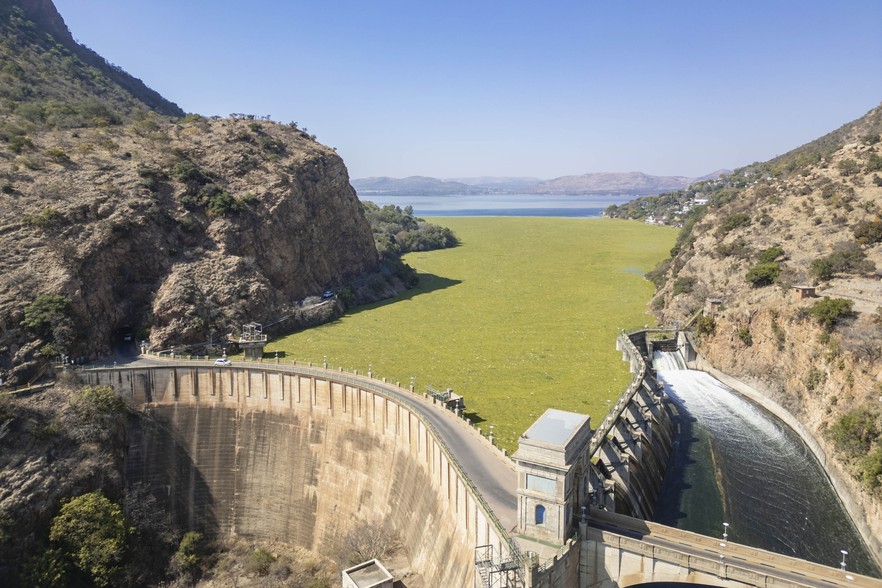
26 August 2025
A green carpet of Salvinia minima, a free-floating, rootless aquatic fern native to South America covers an area near the Hartbeespoort Dam wall in North West province. Photos: Ihsaan Haffejee
Hartbeespoort Dam in North West province is becoming increasingly polluted. High levels of nutrients, including nitrogen and phosphorus, contribute to the growth of invasive plant species and deprive the water of oxygen, harming aquatic life.
On a recent visit, GroundUp found large sections of the dam covered in Salvinia minima, a free-floating, rootless aquatic fern native to South America that thrives in nutrient polluted water. Plastic bottles, polystyrene and even shoes could be seen caught in the floating vegetation.
Residents in the area and businesses that rely on local tourism have expressed concern about the poor water quality of the dam.
Boats sit on a carpet of invasive green vegetation.
John Wesson from the Wildlife Society of South Africa (WESSA) says rivers that feed into the dam, like the Jukskei and Crocodile, are heavily polluted by municipalities, industry and farmers dumping waste.
“Often we find with municipalities that their sewage treatment plants are not functioning, their manholes get blocked or their pumps and cables get stolen, and all that raw sewage gets dumped into the river that flows into the dam,” said Wesson.
WESSA conducts monthly independent water tests. Readings from their July tests show extremely high levels of ammonia and phosphates, far above the standard minimum acceptable levels.
“We don’t even test for E. coli because we know that the E. coli levels in the dam are going to be through the roof,” said Wesson.
A shoe floating on top of the invasive species in the Hartbeespoort Dam.
“It is unfortunate that the crisis that we are facing is predominantly caused by municipalities,” Sello Seitlholo, water and sanitation deputy minister, said earlier this year on a visit to the dam.
He called on Madibeng Local Municipality to address the inadequately treated effluent being released at its water treatment plant into the Hartbeespoort catchment area.
An oversight inspection conducted by Seitlholo at Zandspruit wastewater pump station in March revealed that the plant malfunctions, and this results in over 30-million litres of sewage spilling daily into the Jukskei River and ending up in Hartbeespoort Dam.
Seitlholo named runoff from agriculture and chemicals from industry as other sources of pollution. He said the department was advocating for the polluter-must-pay principle. “So that everyone knows of the repercussions of polluting our water bodies”, said Seitlholo.
Fish found with litter and trash in this illegal fishing net confiscated by authorities.
The department appointed Magalies Water to develop a three-year remedial programme for Hartbeespoort Dam to combat long-standing poor water quality and invasive species.
David Magae, Magalies Water spokesperson, said the company systematically tests water in the dam and in many upstream locations. He said that analysis of the data collected over the past two years confirms that the dam has high nutrient concentrations as well as “significant levels of chlorophyll and algal proliferation”. These findings, he said, show that there is “persistent contamination from upstream activities, which remains the foremost challenge to water quality management in the area”.
Salvinia minima viewed from above as it blows across the Hartbeespoort dam.
Winds blows the carpet of Salvinia minima across the Hartbeespoort dam.
A plastic bottle caught amongst the invasive species at the Hartbeespoort Dam.